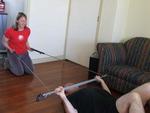Shake up your training
Keep in mind that machine exercises tend to isolate the working muscle,while free weight exercises incorporate additional muscle groups for balance and stability. They both have advantages. Try to find several good exercises for each body part and alternate them regularly.
Pre-Exhaust – In addition to trying new exercises, experiment with their order. If you’ve always
Go Slower – Step into any weight room, and you’re almost guaranteed to see someone struggling with way too much weight, jerky movements and very poor form. Quite a few people are guilty of compromising good form in an attempt to lift heavier. If you’ve reached what seems like the upper limit of your capabilities, try taking a few plates off of your weight load and performing the same movement very, very slowly - try ten counts on the lifting movement and 4 counts on the lowering movement. By moving slowly and precisely through the full range of motion, you totally eliminate momentum, increase tension on the working muscle, and recruit all kinds of additional muscle fibers. You’ll feel it! Be sure to cut back on the number of repetitions when training this way. Your muscle is going to fatigue much more quickly.
 |
Breakdown Training – In a nutshell, this means that once you’ve worked a muscle to failure, you reduce the load and crank out a few more repetitions with a lighter weight. Suppose that you normally do leg curls with 30kg of resistance, and that you reach muscle failure after 10 repetitions. Rather than stopping at the end of the set, you would reduce the weight to 15kg and immediately perform 2 or 3 additional reps. This is another excellent way to up the intensity of the exercise and recruit additional muscle fibers. |
Assisted Training
This concept is very similar to breakdown training, but it requires the help of a partner. Once you reach the point of failure on a particular exercise, your partner steps in and assists you with the movement. So, if after 10 barbell biceps curls, you can’t complete another repetition with good form, your partner would step in and help you lift the bar to the top of the movement. This allows you to perform 2 or 3 post-fatigue repetitions, again upping the intensity and promoting further strength gains.
Periodization – The idea here is to avoid always using the same workload. One way to accomplish this is to set up a program of planned periodization. For example, you might do three weeks of multiple set, high repetition endurance training, followed by three weeks of increased weight and fewer repetitions, followed by three weeks of very heavy single set exercises, followed by a week off. Then you would repeat the pattern. There are numerous ways to approach periodization, but the basic idea is to keep changing the intensity at regular intervals so that your workouts don’t stagnate.
Happy training!
Lisa



